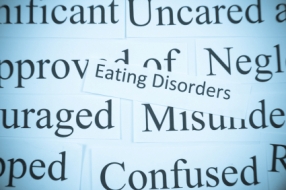 Is there someone in your life whom you worry might have an eating disorder? Do you know how to recognize symptoms of an eating disorder? While some symptoms are obvious, some are simply exaggerations of healthy behaviors taken too far.
Is there someone in your life whom you worry might have an eating disorder? Do you know how to recognize symptoms of an eating disorder? While some symptoms are obvious, some are simply exaggerations of healthy behaviors taken too far.
One obvious symptom of an eating disorder is weight loss or weight fluctuation; however, this does not apply to everyone with an eating disorder. Meghan Bennett, Recovery Care Specialist of Selah House, LLC reminds us that “someone struggling with bulimia or ED NOS (Eating Disorder Not Otherwise Specified) may not experience much weight loss, may be over weight due to binging and purging, or not lose weight rapidly or drastically. The stereotype is that someone must be severely underweight or losing rapidly to have an eating disorder is misleading. Nearly half of the clients I work with in an inpatient ED facility have to do little to no weight restoration.”
Other clues to an eating disorder that are commonly discussed are excessive exercise, binging and/or purging, caloric restriction, picky eating, misuse of laxatives or diet pills, caffeine abuse, and misuse of ipecac or epsom salts.
You may have also heard that people with an eating disorder may quit menstruating, lose hair, experience anemia, damage their teeth, damage to their esophagus, break their fingernails easily, and grow fine hair on their face or body. You may not see that they also experience osteoporosis or osteopenia, heart problems, kidney problems, damage to their colon, low body temperature, and the decreased ability to recognize hunger.
 Some healthy behaviors can become unhealthy if taken to an extreme. One of my dear friends knows the calories and nutrition information at every restaurant we visit because she is having awesome success with Weight Watchers. However, sometimes an obsession with caloric counts and nutritional information can be a signal that someone is looking for an excuse to not eat certain foods. Another healthy behavior that can be taken to far and signal an eating disorder is a focus on eating only organic or raw foods. Meghan Bennett also told me that “an obsession with ‘purity’ in foods is occasionally linked to sexual trauma, the patient wants nothing ‘impure,’ ‘artificial,’ or ‘toxic’ in their body.”
Some healthy behaviors can become unhealthy if taken to an extreme. One of my dear friends knows the calories and nutrition information at every restaurant we visit because she is having awesome success with Weight Watchers. However, sometimes an obsession with caloric counts and nutritional information can be a signal that someone is looking for an excuse to not eat certain foods. Another healthy behavior that can be taken to far and signal an eating disorder is a focus on eating only organic or raw foods. Meghan Bennett also told me that “an obsession with ‘purity’ in foods is occasionally linked to sexual trauma, the patient wants nothing ‘impure,’ ‘artificial,’ or ‘toxic’ in their body.”
Meghan also shared that she looks for some specific behaviors during meal times while she is working at Selah House. Some mealtime behaviors that could signal an eating disorder include: taking very small bites, cutting or tearing food into small pieces, refusing to eat in front of others, eating very slowly or very quickly, eating only one food item at a time, spitting food out after chewing it, drinking a lot of water during meals, hiding food, pushing food around on the plate, avoiding condiments and sauces or making foods inedible by adding too much of sauces or condiments, making food very hot so it is painful or impossible to eat, and adding cinnamon or hot sauce to foods to help boost metabolism.
I want to leave you with a word of warning from Meghan about these symptoms, “However, someone does not have to have any or all of the above listed physical symptoms to have an eating disorder. Often our clients are dismissed by doctors and insurance companies because they are ‘not sick enough.’ In reality, these clients are living in the daily torment of an eating disorder that is controlling their lives.”
If you are concerned about someone you know suffering from an eating disorder, please address it with them, but do so gently and compassionately. Remember that an eating disorder is often something that someone uses to not deal with other emotions that may be even more painful than the eating disorder itself. While they may want help, they may fear what life will be like for them without an eating disorder.

I have an issue with eating small pieces of food, such as half a cracker or a corner of a piece of bread. This is usually inbetween meals, when I get hungry, but don’t want to have a snack. It seems to be getting worse. I am not sure if this is common, but I really want to stop.